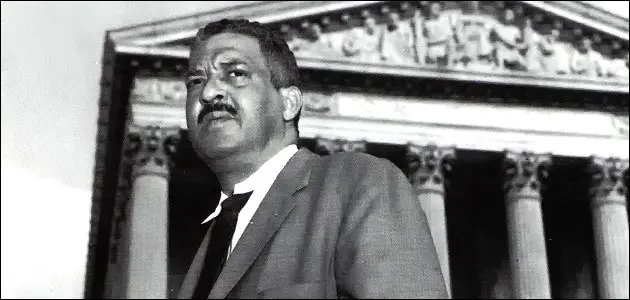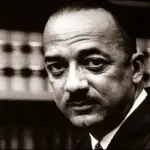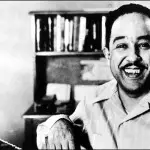Thurgood Marshall
Thurgood Marshall is known as the first Black Justice of the United States Supreme Court but he is really defined by his work as a civil rights lawyer which redefined life in the United States.
Thoroughgood Marshall was born in Baltimore, Maryland on July 2, 1908, the great grandson of a slave born in Congo. His grandfather was also a slave and his father, William, was a railroad porter. He changed his name to Thurgood while in grade school. He attended high school in Baltimore at Frederick Douglas High School. He attended Lincoln University in Oxford, Pennsylvania, the first degree-issuing Historically Black College. He was a member of Alpha Phi Alpha fraternity and among his classmates were author and poet Langston Hughes, the future President of Ghana, Kwame Nkrumah, and musician Cab Calloway. During his senior year, in 1929, he married Vivian “Buster” Burey (their marriage would last until her death from cancer in 1955).
The following year Marshall applied to the University of Maryland Law School but was denied entrance on the basis of his race. For Marshall, this would be a life-altering moment as it would help to direct the course of his life. He attended Howard University Law School instead, where he studied under his professor William Hastie and Dean Charles Hamilton Houston. He graduated from Howard Law School in 1933, ranked first in his class.
One of the main priorities that Houston had laid out for his students was the overturning of Plessy v. Ferguson, which allowed for segregation based on the principle of separate but equal. Marshall wasted no time in that pursuit as he took on the case of Donald Gaines Murray, a Black graduate of Amherst College, who had also been denied admission to the University of Maryland Law School because of its segregation policy despite his excellent credentials. He took the case to court in 1935 (Murray v. Pearson, Raymond Pearson being the President of the University). He was assisted by his Dean, Charles Houston, who developed much of the strategy. Their approach to the case was to use Nathan Ross Margold’s strategy of attacking the concept of separate but equal by using the “equal protection clause of the fourteenth amendment to the U.S. Constitution. The state of Maryland argued that it would comply with the requirements of “separate but equal” by providing him with a separate but equal opportunity to attend a law school even if it had to pay for him to attend a school outside of the state. Marshall argued that because the University would not accept Black candidates, their only alternatives were to attend Morgan College or the Princess Anne Academy. Neither of these institutions had a law school, nor were they equivalent to the University of Maryland academically. He further argued that because states vary in the understanding of different legal matters and the different manners of the implementation of the law, no other state would be able to adequately prepare Murray to practice the laws of the state of Maryland. He said “since the state of Maryland had not provided a comparable law school for blacks that Murray should be allowed to attend the white university.” He followed by saying “What’s at stake here is more than the rights of my client. It’s the moral commitment stated in our country’s creed.” Thus, the premise of separate but equal could not be applied. The Maryland Court of Appeals agreed and ordered the President of the University to admit Murray to the law school. The court stated “compliance with the Constitution cannot be deferred at the will of the state. Whatever system is adopted for legal education must furnish equality of treatment now.” Author H.L. Mencken celebrated the victory by chastising the University, opining that it should desire the “presence among them of a self-respecting and ambitious young Afro-American well prepared for his studies by four years of hard work in a class A college.”
In 1936, Marshall opened his own private practice but also worked as the lead counsel for the National Association for the Advancement of Colored People (NAACP). He won his first case in front of the U.S. Supreme Court, Chamber v. Florida and would argue another 31 in front of the high court. The most famous of these, and perhaps the most important, was the Brown v. Board of Education of Topeka, the case which ended legal segregation within the United States. The case was brought by thirteen Topeka parents on behalf of their twenty children and the named plaintiff was Oliver L. Brown on behalf of his daughter Linda. Linda was forced to walk six blocks and through a railway yard to a bus stop in order to catch a bus to take her to a Black school more than a mile away from her home while there was a white school about seven blocks from her home. At the behest of the NAACP, Oliver walked his daughter to the white school and attempted to enroll her in it. His request was denied and he was directed to the Black school, a mile away.
The case was first argued in front of a district court which found that while segregation in public education was detrimental to Black children, the white and Black schools in question were satisfactorily similar in regards to buildings, transportation, curriculum and educational qualifications of teachers to satisfy the standards required by Plessy v. Ferguson. The case was subsequently appealed and would end up being heard by the United States Supreme Court. The Court, in order to decide on the issue once and for all, combined the Brown case with four others: Briggs v. Elliott (originally filed in South Carolina), Davis v. County School Board of Prince Edward County (Virginia), Gebhart v. Belton (Delaware), and Bolling v. Sharpe (Washington D.C.). All of the cases were sponsored by the NAACP so Marshall argued them before the Supreme Court.
Although the court was unable to decide the issue when it was heard in the spring of 1953, Justice Felix Frankfurther wanted it reheard in the fall in order to gain a unanimous decision. When Earl Warren was appointed to the Court as Chief Justice, he proposed that the real issue to be decided was whether segregation could be sustained under the belief of the inherent inferiority of the Negro. Under this premise none of the Justices could in good faith continue to support segregation and the court voted unanimously to overturn Plessy v. Ferguson. The court held that even in situation where all relevant factors were equal, a significant psychological and social disadvantage was placed on Black children, from the nature of segregation itself, and was therefore harmful and unconstitutional. The statement from the said, in part:
“Does segregation of children in public schools solely on the basis of race, even though the physical facilities and other “tangible” factors may be equal, deprive the children of the minority group of equal educational opportunities? We believe that it does… Segregation of white and colored children in public schools has a detrimental effect upon the colored children. The impact is greater when it has the sanction of the law, for the policy of separating the races is usually interpreted as denoting the inferiority of the Negro group. A sense of inferiority affects the motivation of a child to learn. Segregation with the sanction of law, therefore, has a tendency to [retard] the educational and mental development of Negro children and to deprive them of some of the benefits they would receive in a racial[ly] integrated school system… We conclude that, in the field of public education, the doctrine of “separate but equal” has no place.”
While the Brown was his most famous victory in front of the U.S. Supreme Court, he, in fact, won 29 of the 32 cases he argued in front of the Court.
After the death of his first wife, Marshall married Cecilia Suyat in December 1955, The couple would have two sons together.
In 1961, Marshall was appointed by President John Kennedy to the United States Court of Appeals for the Second Circuit under a recess appointment (Senator James Eastland of Mississippi and a number of other southern senators attempted to hold up his confirmation). He served in this position until 1965 when President Lyndon Johnson appointed him to serve at the United States Solicitor General. As the Solicitor General, he represented the Federal government of United States in arguments before the U.S. Supreme Court. He was the first Black appointed to the position and would win 14 of the 19 cases he argued in that role.
 Finally, on June 13, 1967, President Johnson nominated Marshall to the United States Supreme Court. In nominating Marshall for a position on the highest court in the land, Johnson said that it was “the right thing to do, the right time to do it, the right man and the right place.” Marshall was confirmed as an Associate Justice by a Senate vote of 69–11 on August 30, 1967. He served on the Court for 24 years, championing the plights of women and minorities, safeguarding the rights of criminal suspects and working against the death penalty.
Finally, on June 13, 1967, President Johnson nominated Marshall to the United States Supreme Court. In nominating Marshall for a position on the highest court in the land, Johnson said that it was “the right thing to do, the right time to do it, the right man and the right place.” Marshall was confirmed as an Associate Justice by a Senate vote of 69–11 on August 30, 1967. He served on the Court for 24 years, championing the plights of women and minorities, safeguarding the rights of criminal suspects and working against the death penalty.
Marshall died of heart failure at in Bethesda, Maryland, on January 24, 1993 at the age of 84 and was buried in Arlington National Cemetery. Numerous monuments and memorials were dedicated to his memory including Baltimore International Thurgood Marshall Airport being named after him. More importantly, his legacy as civil rights pioneer and as an advocate for change within the legal system will be remembered for changing the landscape of American culture for years to come.
Search for more about Thurgood Marshall



 Like Us on Facebook
Like Us on Facebook Tweet Us on Twitter
Tweet Us on Twitter Watch Us on YouTube
Watch Us on YouTube Pin Us on Pinterest
Pin Us on Pinterest Link to Us on LinkedIn
Link to Us on LinkedIn Adscape International, LLC
Adscape International, LLC PO Box 173 Brandywine, MD 20613
PO Box 173 Brandywine, MD 20613 240-244-9660
240-244-9660


Leave a Reply
Want to join the discussion?Feel free to contribute!